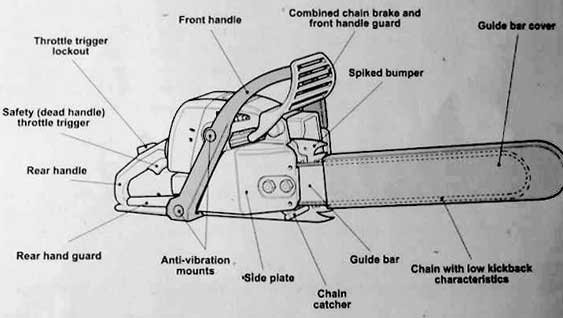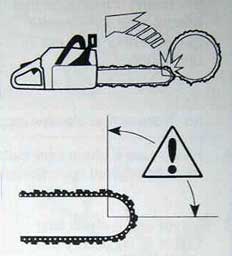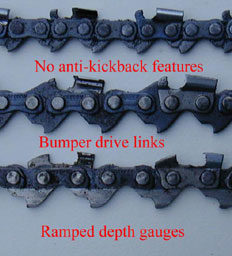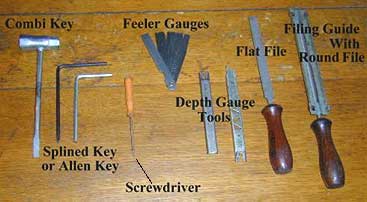What
to look out for on your chosen weapon...  |
ON-OFF SWITCH: Must be clearly marked and functional. Watch out for some models
of saw where it's easy to switch off the saw by accident with your thumb when
tipping the saw on it's side. The chainsaw switch works by making a contact (a
normal switch breaks the contact), thereby short circuiting the ignition system.
This means that if the switch fails in use, then the saw will not switch off.
If this happens, the procedure is to apply the chain break and activate the choke,
this floods the saw and stops it.
FRONT HAND GUARD /
CHAIN BRAKE: The front hand guard is absolutely essential and must be
in place on all chainsaws, even old ones. Only very old chainsaws come with a
front hand guard alone. All modern saws (that I'm aware of) have it combined with
a chain break mechanism that activates if the left hand (which grips the front
handle) hits, or pushes, the guard. This stops the chain within a fraction of
a second. With most saws it is also activated if the saw "kicks back"
whether the hand hits it or not. This is a very useful feature if you want to
avoid receiving a running chainsaw full in the face or through the shoulder in
the event of a snag and a "kickback".
CHAIN
CATCHER: A little tab below the guide bar on the body of the saw. It's
designed to catch the chain and prevent it from being thrown off the saw in the
event of a breakage. It also reduces the amount that the chain can whip back under
the saw possibly hitting the operator on the right hand, leg or crotch. It's also
worth mentioning that you should not point a working chainsaw at anyone nearby
(the nearest anyone should be is 5 metres), if the chain does get thrown off it
may hit someone, it could be travelling up to 50 mph.
SAFETY
THROTTLE: The throttle trigger is designed to lock off if a hand is not
firmly grasping the rear handle (dead mans handle). This prevents twigs etc. from
activating the throttle whilst the saw is being carried when switched on.
CHAIN BREAKAGE GUARD: A protective flange on the rear handle protecting
the operators right hand from being hit by a broken chain whipping under the saw.
ANTI-VIBRATION MOUNTS: These mounts isolate the engine
part of the saw from the handles, considerably reducing the amount of vibration
transmitted to the operators hands (wearing the gloves reduces the vibration further).
This is very important to reduce the likelihood of the operator developing damage
to the circulation in his/her fingers (white finger syndrome). The mounts are
made of steel springs or rubber. The rubber ones are prone to perishing due to
the effects of fuel and oil and must be checked and replaced quite regularly.
If any of the mounts fail, the saw will flop about loosely in the handles and
will transmit a lot of vibration to the user. Very old saws may not have these
features and are likely to cause the operator a lot of discomfort. The operator
is also likely to be storing up lots of health problems for the future.
SILENCER: This must direct the exhaust fumes away from the operator.
Invariably directed into the exhaust airflow from the engine cooling fan. On top
handled saws it is directed backwards and to the right. With rear handled saws
it's usually directed forwards to the right, over the top of the guide bar and
chain. The silencer must be kept in good order, not only to reduce noise, but
also to reduce the likelihood of the operator breathing in exhaust fumes.
GUIDE BAR AND CHAIN: First the guide bar. Your guide
bar may be solid nose or sprocket nose, but in order to reduce any "kickback"
to a minimum it should be as small a radius as you can find for your saw. This
reduces the area in which the chain digs in if touching an obstacle. The danger
area is the front, top third of the nose of the bar. The chain should be chosen
with anti-kickback features in mind (most chains sold in Britain for hand held
chainsaws come with this feature as standard). The anti-kickback feature is normally
a long ramp of some sort that helps the chain feed smoothly into the wood - e.g.
Bumper drive links; Ramped depth gauges; Bumper tie straps (not shown).
|
 |  |
Kickback
area of Guide Bar
| Anti-Kickback
features of Chain
| CHAIN
COVER: A plastic guard is normally supplied
for this purpose. It is an inexpensive piece of kit to replace and should be in
place whenever the saw is not being used. More cuts are suffered from unprotected
stationary chains than from moving ones. Homemade plywood guards and old wellies
can be used by the miserly.
STICKERS:
Strangely enough these are a legal requirement
in UK. The saw must carry head, ear, eye defender symbols on a sticker attached
to the saw. There is no prohibition on lightning or flame "boy racer"
type symbols on the saw (unlike that for the helmet).
TOOLKIT: Unfortunately most saws seem to
come with only one combination key as the toolkit. This is woefully inadequate.
The operator should have the full toolkit required for regular, general maintenance
of the chainsaw. The full tool kit complement can be found by reading the chainsaw
owners manual for the make of saw. If you've bought your saw second hand then
find the dealer for that particular make and order a copy, then read it from cover
to cover at least 500 times.
A
standard tool kit usually comprises of: Combination side case/plug spanner come
screwdriver (combi key); Allen key or splined screwdriver (for other screws);
Small screwdriver (for idle adjustment); Feeler gauges (for sparkplug); Bar groove
cleaner (with pointy bit for poking dirt out of oil holes); Depth gauge setting
tool (to set the height of the depth gauges on the cutters); Small flat file (for
filing down depth gauges and removing burrs plus dressing guide bars); Appropriate
round chainsaw file complete with the proper filing guide for the sharpening of
the chain supplied with the chainsaw. | 
So there's quite a lot
more than you might expect. We're not dealing with just another power tool.
|
| |


